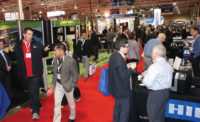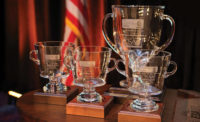
|
| AIREF chair John Jennings, left, and AIREF Golf co-chair, Jamie Orvis, right, anchor a team at the AIREF annual golf tournament with Mark Sandler and Michael Keegan. |
The Alarm Industry Research & Educational Foundation (AIREF) represents the electronic life safety, security and systems industry, under the auspices of the Electronic Security Association (ESA). Since AIREF’s beginnings in 1977, foundation members have been focused on improving education in the alarm industry as well as conducting research that public safety officials can use to better protect and serve the community, and dealers, distributors, manufacturers and monitoring stations can use to increase acceptance of their products and improve public relations.
Aside from its one major fundraising initiative each year — the annual golf outing — many industry newcomers and veterans alike may be unaware of the faces behind the foundation, its current and past research projects and its educational initiatives — as well as how alarm companies can potentially benefit from the organization’s work.
The foundation raises approximately $125,000 annually, and has spent around $500,000 to $600,000 collectively in the last five years on research projects and industry training improvements. One of AIREF’s current research projects, in partnership with University of North Carolina, Charlotte, includes surveying convicted burglars about why they chose to burglarize specific homes and the effectiveness of alarm signs and systems as a deterrent to burglars. SDM spoke with John Jennings, chair of AIREF, to learn more about the foundation’s current projects, its mission and goals.
SDM: Tell us about AIREF.
Jennings: AIREF has been around since the late ‘70s. Originally, when it was founded, we published a lot of history books on the industry and in the late ‘80s we did a couple of studies. Over the past few years [this year’s 2011 golf outing was the organization’s 8th annual event], the annual golf tournament has allowed us to raise about $100,000 a year.
SDM: What purpose does the foundation serve for the alarm industry?
Jennings: I think the main purpose of our foundation is to validate the importance of an alarm system and increase training and knowledge of the technicians on the job. It is not just about, ‘Well I put an alarm system in and now I feel better.’ It is about whether it really serves a purpose.

|
Jennings: We have three recent research projects: a Rutgers study on the effectiveness of alarms; a study on how citizens view verified response in Salt Lake City; and a University of North Carolina, Charlotte study on how to truly measure false alarm statements versus just saying 98 percent of alarms are all false, for example. We also just signed a contract with UNC Charlotte for another study to interview convicted burglars.SDM: Tell us about some of AIREF’s most recent research projects.
SDM: How do you plan on interviewing burglars and how can the alarm industry potentially benefit from such a study?
Jennings: It is an independent study we’re funding that will survey convicted burglars on why they broke into particular properties versus why they didn’t. We will find out if alarm systems were in those properties and if things like lawn signs deterred them. UNC Charlotte will conduct the entire study and it will be interesting to see what we get back. It is our most important study that we’ve started to date and should be done by May or June of next year.
SDM: What are some of the other projects AIREF funds with its annual budget?
Jennings: We just authorized $10,000 for printing books of a new study by the Department of Justice called, “Building Your Way Out of Crime.” We’re working with the ESA training school on its online technician classes. NTS is also one of our biggest beneficiaries — and we are really starting to help it redevelop its courses into the 21st century model.
SDM: What is something that people new to the alarm industry or unfamiliar with AIREF might not know about the organization?
Jennings: I think it would be the importance of the work we do as far as research and studies. Anytime you can take a study from a university that was independent and put those facts in front of people, I think that serves our industry well and any alarm organization or alarm company well. When I go to the ESA convention every year, I’m always surprised by how many chapter presidents don’t know about AIREF. We’re one of the industry’s well-kept secrets. One of my goals this year is to really educate the industry on what AIREF is and what we do so we’re not a well-kept secret anymore.
SDM: How can people get involved?
Jennings: Support AIREF. If you stand up and support AIREF, it will come right back to you. You will have validated information that can be used to ward off verified response and show the true importance of an alarm system. People can go online and donate through our website, www.airef.org. We can use all the help we can get.
| A Glance at AIREF’s Completed Research Projects |
|
An Assessment of the Calculation Process and Validity of False Alarm Estimates This report focuses on how to measure false alarm rates and offers suggestions for improved false alarm calculations and reporting. The Effectiveness of Alarm Systems This study, completed by Rutgers University School of Criminal Justice, took a look at five years of statistics to determine the effectiveness of alarm systems. One of the findings was that residential burglar alarm systems do help deter crime. Verified Response Study in Salt Lake City Researchers looked at verified response in Salt Lake City and found that 65 percent of registered voters in the community disapproved of verified response and would vote for politicians who would change it. |
| AIREF’s Latest Study: Learning from Convicted Burglars |
| The Alarm Industry Research & Educational Foundation is currently conducting a study that it has commissioned with the University of North Carolina, Charlotte, to interview convicted burglars and assess why particular properties are broken into, as well as the effectiveness of alarm systems as deterrents. The project is expected to be completed by June 2012. |
| Who’s Who at The Alarm Industry Research & Educational Foundation |
|
Chair: John Jennings, Safeguard Security Services Inc., Scottsdale, Ariz. Secretary: Ed Solt, OpenEye Inc., Liberty Lake, Wash. Treasurer and AIREF Golf Co-Chair: Jamie Orvis, Security Solutions Inc., Norwalk, Conn. AIREF Golf Co-Chair: Bart Didden, U.S.A. Central Station Alarm Corp., Port Chester, N.Y. Voting Keith Baird, Honeywell Security, Louisville, Ky. Members: Charles Darsch, System Sensor, Sudbury, Mass. Cecil Hogan, Security Consultants Inc., Memphis, Tenn. Gary Kallman, 3VR Security Inc., San Francisco Bryan Lawrence, Buchanan Ingersoll & Rooney, Pittsburgh Kirk MacDowell, Interlogix, Tualatin, Ore. Glen Mowrey, SIAC, Charlotte, N.C. Richard Soloway, NAPCO Security Group, Amityville, N.Y. Ex-Officio Member: Stan Martin, Executive Director, SIAC, Frisco, Texas Executive Director, ESA: Merlin Guilbeau, Irving, Texas ESA Past President: Mike Miller, Moon Security Services, Pasco, Wash. |







